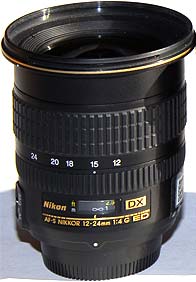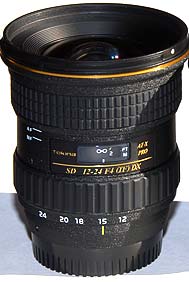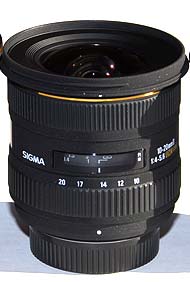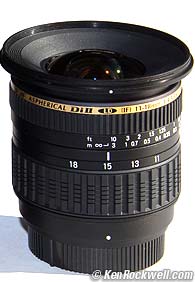Home Search Gallery How-To Books Links Workshops About Contact © 2006 KenRockwell.com
Nikon
12 - 24 mm f/4, Tokina 12 - 24 mm f/4, Sigma 10 - 20 mm f/4 - 5.6
and Tamron 11 - 18 mm f/4.5 - 5.6. Introduction These are all sharp in the center, even wide open. They differ as you get away from the center of the image. Unless I needed to make 60 x 120" prints and look at them under a microscope I'd be happy with any of these. The only way I can show all this accurately is with a lot of high quality images. Those of you on dial-up will have to satisfy yourselves with my written descriptions since the coming pages will take 10 minutes to load over a phone line. I'm going to show a bunch of crops at 100%. On a typical 85 DPI computer screen these clips represent what you'd see from a 54" (4.5 foot) wide print. Would you look at a 4.5 foot wide print as close as you look at your monitor? Probably not. You'd stand back and admire what a great photographer you are. How I Did This These shots are from my D200. On a D50 or D70 or D1X or D2H you'll see much less difference since those cameras have less resolution. Less resolution means less magnification when you blow up to 100% on screen. All were shot in Large, optimize quality JPG Normal. They were cropped in PS CS2 and "saved for web" at 80%, which looks the same as the original file. I chose 12 and 18 mm as focal lengths every lens could do. I chose f/5.6 as the largest aperture every lens could do. I chose f/11 as two stops down and likely the sharpest aperture before diffraction limits every lens' sharpness. Zoom lenses, especially wide zoom lenses, are more complex than you can possibly imagine without a PhD in mathematics. These results might look completely different at different focal lengths or apertures. Diffraction makes them similar at tiny apertures like f/16 and f/22, which is why I don't bother comparing them there. Lens performance varies all over the field of the lens. Manufacturing differences will exaggerate these when testing single samples. Some lenses may do better in the corners while others do better elsewhere. Don't freak out and be a victim of analysis paralysis. Any of these lenses has the ability to let you create stunning images if you'll just get out there and stop reading test reports. Sample Variations Lenses are complex and precise mechanical devices. Unlike computer software, any mechanical variations in manufacture will affect optical performance. Zoom lenses have internally moving parts and are especially prone to manufacturing variations. Wide angle lenses are smaller than other lenses, so any constant mechanical deviation is even more significant in the manufacture of a wide lens. Therefore wide zooms can have performance that varies from one sample to the next. I've only tested one random sample for each. I can't vouch if you buy one if it will be better or worse. I used to think magazines got cherry-picked samples for testing. Maybe they do, but also I've learned that just as often they get a beater demo unit that's been dropped many times at trade shows. You never know. You of course need to try out any lens you buy, which with digital is trivial. Next: Sharpness at 12 mm |
Home Search Gallery How-To Books Links Workshops About Contact





